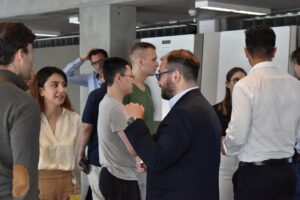Empowering the Energy Transition: Highlights from the Power Grid Model Meet-up in Bellevue
By Ashley Reulink, Alliander
On 6 June, the third biannual Power Grid Model meet-up took place in Bellevue in Arnhem. With over 30 attendees present and an additional 50 participants joining online, the event brought together individuals with a keen interest in the Power Grid Model. It was a truly delightful afternoon, featuring insightful guest speakers, demo session, roadmap session and a pleasant closing reception. As the challenges on the electricity grid intensify due to growing energy demands, it becomes crucial to swiftly identify and address these issues. Collaborations that contribute to the Power Grid Model hold immense value and can accelerate the energy transition by offering timely solutions.
The increasing adoption of renewable energy and the electrification of energy consumption have led to a rise in congestion. Congestion occurs when overloaded assets, such as cables and transformers, are unable to handle additional electricity flow due to the risk of overheating. Therefore, it is crucial to detect congestion to mitigate its effects. Determining the most suitable contingency scenario to mitigate its effects requires evaluating the potential impact of various scenarios through simulations of electrical power grids. Alliander has developed the Power Grid Model to create these simulations. It enables in-depth studies and analysis of the electrical power grid’s behavior and performance. This comprehensive model incorporates essential factors such as power generation capacity, electrical losses, voltage levels, power flows, and system stability. The Power Grid Model finds applications in various areas, including grid planning, expansion, reliability, and congestion studies. Notably, the Power Grid Model outperforms similar tools in terms of its performance capabilities.

The Power Grid Model meet-up aims to ignite enthusiasm among new participants while providing those already involved with an opportunity to share their feedback. Following Tony Xiang’s opening remarks, Rinke van de Rhee, Chief Digital Officer, took the stage to address Alliander’s most significant challenge to date: “the second energy transition.” He emphasized the increasing strain on the electricity grid caused by the increasing adoption of sustainable energy and electrification of energy consumption. To address this, he highlighted the importance of digitization, which can streamline operations and optimize grid utilization through innovative and intelligent solutions. Open-source collaborations are important for achieving this digitalization.

Next, Demetris Chrysostomou took the stage and presented his PhD research from TU Delft titled “Graph Neural Learning for Control Coordination for Transmission and Distribution Grid Operation Stability.” His research was motivated by the need for more flexibility to maintain stability within the transmission and distribution grids. Delving into the current state-of-the-art methods for Power Flow in academia, Demetris delivered an engaging visual presentation. Notably, he offered insightful comparisons between the PandaPower Power Monte Carlo Flow Method and the Power Grid Model Monte Carlo Power Flow Method. The results clearly demonstrated the exceptional speed of the Power Grid Model, which proved to be 100 times faster than PandaPower in simulating power flow scenarios.
The final speaker of the afternoon was Francesca Soldan from the Energy System Research institute (RSE S.p.A.), a research company wholly owned by the Italian government. The presentation titled “Integration of Power Grid Model power flow into the Multi-Energy Semantic Platform (MESP)” focused on international standards for managing and studying multi-energy networks. They explored how the Power Grid Model can be used in their Multi-Energy Semantic Platform (MESP) to simulate the power flows in electrical power grids. Also, they compared Power Grid Model with MATPOWER. Power Grid Model demonstrated remarkable efficiency, delivering results up to 100 times faster when testing networks. This was achieved while maintaining optimal execution times for the algorithms on simulated networks. A possible next step of RSE is to look into the use Power Grid Model for low-voltage grid simulations.

Following these presentations, the attendees were divided into two groups. One group had the opportunity to attend a live demo by Peter Salemink, providing insights into the functionality of the Power Grid Model. Meanwhile, the other group engaged in a semi-annual roadmap session, collectively exploring ways to elevate the Power Grid Model to new heights in the upcoming six months. To wrap up the productive afternoon, a delightful social gathering took place, allowing participants to further discuss the valuable information exchanged throughout the day.

We sincerely appreciate everyone’s attendance, and we are excited about the prospect of collaborating with you to enhance and expand the Power Grid Model in the next six months, guided by your valuable feedback.
If you are interested in learning more about the Power Grid Model and how you can contribute, we encourage you to visit the project page or explore the technical documentation. Or, if you were not present at the meet-up, you can rewatch the meet-up via this link.
